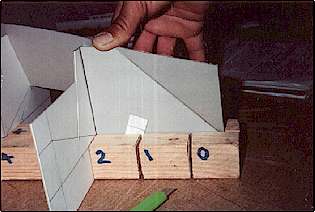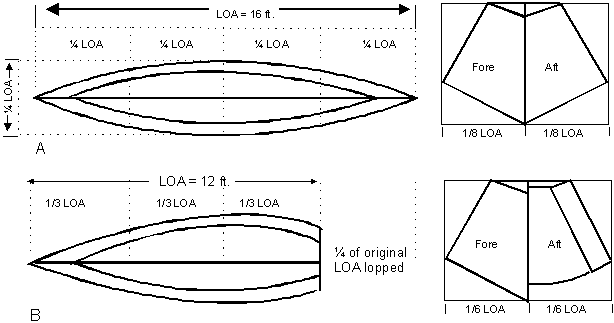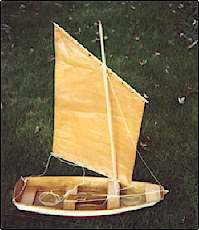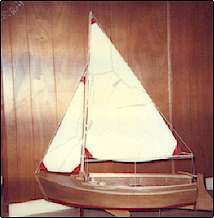|
A (Kind of) Philosophical Introduction
Our whole life is built on certain presumptions. Some of these ideas
are facts that are easy to prove, i.e., the law of gravity. When they
can’t be proved, they are called axioms. In the
mathematics we learned in secondary school, the axiom is that the shortest
(and fastest) connection between two points is a straight line. This may
be true on earth but it seems to be different in space travel.
Here is an axiom for boat builders: For a Double-Ender, the best
compromise between Overall Length and Beam is expressed by the ratio
LOA/Bm = 4/1. This does not mean that the ratios
3½ to 1, or 4½ to 1, are no good. It does mean
that with the 3½ to 1 ratio the hull is a bit more stable
and slower. With the ratio 4½ to 1 the boat is faster,
but also more tender. It is the designer who makes the decision in the
trade-off.
With everything in life, we start out as amateurs. We try to become as
professional as possible as soon as possible. The process is different for
every individual. It is during this process that
we form our opinions. This is the reason so many sometimes-bewilderingly
different suggestions turn up on the net when a newbie asks where and how
to start. Recently, one person even called that question: “Opening a can
of worms.” Also, everybody believes that his/her way is the best. That is
good. Mohammed Ali would never have been world champion had he even for
only one moment thought that he was second best.
In 1975, to work off frustrations, I chose boat building as a hobby.
After having built a couple of hard chined boats, it dawned on me that the
shape of that type of hull is based on some very simple mathematics. That
was also the moment that I found out how bad my memory of mathematics had
become.
I live in a suburb of Montreal, Canada. I have relatives in Toronto,
Ottawa, and Halifax. I went to all the public libraries of these cities
and scanned all the sections #623 on building boats. During those years, I
read all the magazines that are published on the subject in the USA,
England, and Holland. I collected a substantial library of my own.
 I
suffered from a near terminal case of Boat Building Book and Magazine
addiction. It lasted 12 years. After I had overcome that, only one
remark had pointed me in the right direction. The late John Gardner, in
The Dory Book, makes that remark when he states, “All Dories are developed
from Double-Enders. Their sheer line is part of a circle arc.” In
his book, on page 43, he calls that “a natural curve.” In
addition, there was another piece of advice that has saved me a fortune in
money, time, and effort. It allowed me to pick up a lot of experience
without it costing me an arm and a leg. Harold “Dynamite” Payson gives
this advice in one of his books. Abbreviated, he states, “If you build a
model first, you don’t have to buy the wood twice.” It made me laugh.
Especially later, after the many times I goofed, I was laughing all the
way to the bank. I
suffered from a near terminal case of Boat Building Book and Magazine
addiction. It lasted 12 years. After I had overcome that, only one
remark had pointed me in the right direction. The late John Gardner, in
The Dory Book, makes that remark when he states, “All Dories are developed
from Double-Enders. Their sheer line is part of a circle arc.” In
his book, on page 43, he calls that “a natural curve.” In
addition, there was another piece of advice that has saved me a fortune in
money, time, and effort. It allowed me to pick up a lot of experience
without it costing me an arm and a leg. Harold “Dynamite” Payson gives
this advice in one of his books. Abbreviated, he states, “If you build a
model first, you don’t have to buy the wood twice.” It made me laugh.
Especially later, after the many times I goofed, I was laughing all the
way to the bank.
A to-scale model can be built on the kitchen table in wintertime. No
more boat-builders hibernation period during that time. As a
carport-boat-building amateur, I had the too-long, North-American
cold season licked! I had gained a head start on the too-short
summertime.
Matryoshkas
Matryoshkas are boxes mostly in the form of a (Russian) doll. Take off
the cover; a new doll of exactly the same shape is fitted in. This goes on
until the last doll has become too small to hollow out further. The
principle is applicable to the design of hard-chined hulls with three
exceptions:
1. The new hull has a
(slight) change in form fore, or aft, or both.
2. The reduced form is given a new
name.
3. The width of the original sheer
line does not change.
Figure 1-1 shows the Plan view and the Body view of a Double Ender. The
ratio Overall Length to Beam is LOA/Bm = 4/1. Because
fore and aft are mirror image identical, it is one of the easiest hulls to
build.

Fig. 1 - 1 Plan and Body view of a
Double-Ender
DORY
In figure 1-2, only one thing changed in the drawing: A
raked, triangular transom board, called the “tombstone”, replaces the
curved, difficult-to-make-varying-crosscut-angled stern stem. The
tombstone has a strong camber. For the builder, that simplification was a
big time saver. For the fisherman, it meant additional safety. With an oar
in the sculling hole, the boat obtains a rudder. What is more important,
if one oar is lost or broken, it is still possible to scull back to the
mother ship, or, for the inshore fisherman, back to land instead of
helplessly drifting out with the wrong current. Little things like that
sometimes make the difference between life and death on a wide ocean.

Fig. 1 - 2
Tombstone replaces stern stem
The apex of the V-board starts where the heel of the stem
and the chine lines came together. The only change is that the sheer lines
become a bit shorter. The Overall Length is now: LOA =15¼ ft.
The modification changed a DOUBLE-ENDER into DORY.
SKIFF

Fig. 1 - 3 From
Double-Ender to Skiff
 Figure
1-3A is the Plan and Body view of the original Double-Ender. In figure
1-3B one quarter of the Overall Length (¼ LOA) is lopped.
The hole is closed up with a (vertical) stern board called transom. In
this hull the ratio Overall Length to Beam is LOA/Bm = 3/1. Figure
1-3A is the Plan and Body view of the original Double-Ender. In figure
1-3B one quarter of the Overall Length (¼ LOA) is lopped.
The hole is closed up with a (vertical) stern board called transom. In
this hull the ratio Overall Length to Beam is LOA/Bm = 3/1.
Although it has not moved, Beam is no longer in the middle
of the hull. It is located at 2/3 of the Overall Length.
Again, only the sheer lines are shortened. Subsequently, the length
Overall became LOA = 12 feet. The boat type is now called
a 12' Skiff.
A raked transom board improves the beauty of the lines and
increases the Overall Length. For the untrained eye, it also becomes more
difficult to recognize the origin of the lines. Note the decreased bottom
rocker aft and the transom camber in the drawing.
PUNT

Fig. 1 - 4 From
Skiff to Punt
 In
figure 1-4B, a bow board replaces the bow stem of the Skiff of figure
1-4A. The name Skiff becomes Punt.
In figure 1-4B, the locations of the station lines of the original
Double-Ender are placed above the figure in the drawing. The reason for
this is that the Punt does not have to be constructed as shown. The type
of hull allows for great freedom in Overall Length as long as you stay
in the confinement of, and use the original sheer lines of the
Double-Ender. The raking transom board is placed anywhere between
stations #12 and #15. The pleasing lines of the roomy Punt in the picture
were obtained by making the ratios between the width of the sheers of bow
board, Beam, and transom board: In
figure 1-4B, a bow board replaces the bow stem of the Skiff of figure
1-4A. The name Skiff becomes Punt.
In figure 1-4B, the locations of the station lines of the original
Double-Ender are placed above the figure in the drawing. The reason for
this is that the Punt does not have to be constructed as shown. The type
of hull allows for great freedom in Overall Length as long as you stay
in the confinement of, and use the original sheer lines of the
Double-Ender. The raking transom board is placed anywhere between
stations #12 and #15. The pleasing lines of the roomy Punt in the picture
were obtained by making the ratios between the width of the sheers of bow
board, Beam, and transom board:
Bb / Beam / Tb = 18 / 48 / 30 = 3 / 8 / 5.
DINGHY
Shorten a Punt fore end further. Now it is called a
Dinghy. The 10-ft. M-Dinghy, an English design, is a
typical example. It is built and sailed all over the world.
PRAM
If a Dinghy is shortened so far that the bow board is
against the mast bench, and the Overall Length does not amount to more
than eight feet, the Dinghy is called a Pram.
It is difficult to say exactly at what point a Dinghy changes over to a
Pram. Both types are mainly used as service tenders for bigger boats and
as sail trainers in yacht clubs.https://
CONCLUSION
 The
great number of different types of small craft names can sometimes
bewilder and frighten an aspiring amateur. Once you get the drift of how
each type of boat is put together, procrastination about which to build is
easy to overcome. Take heart: If you can build a simple Double-Ender, you
can build them all. And this is only the beginning. In the next posting
more simplifications will make designing and building your own boat even
easier. Find out how to draw the first line mathematically correctly
without the use of those */*&*/* offset tables. The
great number of different types of small craft names can sometimes
bewilder and frighten an aspiring amateur. Once you get the drift of how
each type of boat is put together, procrastination about which to build is
easy to overcome. Take heart: If you can build a simple Double-Ender, you
can build them all. And this is only the beginning. In the next posting
more simplifications will make designing and building your own boat even
easier. Find out how to draw the first line mathematically correctly
without the use of those */*&*/* offset tables.
Sheers and Chines, Barend |